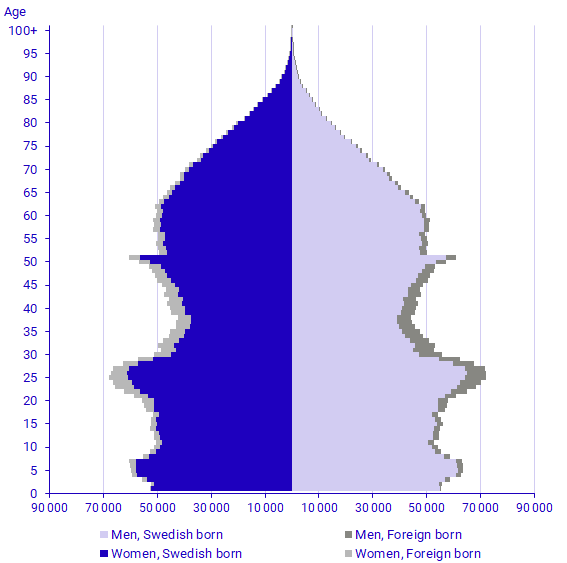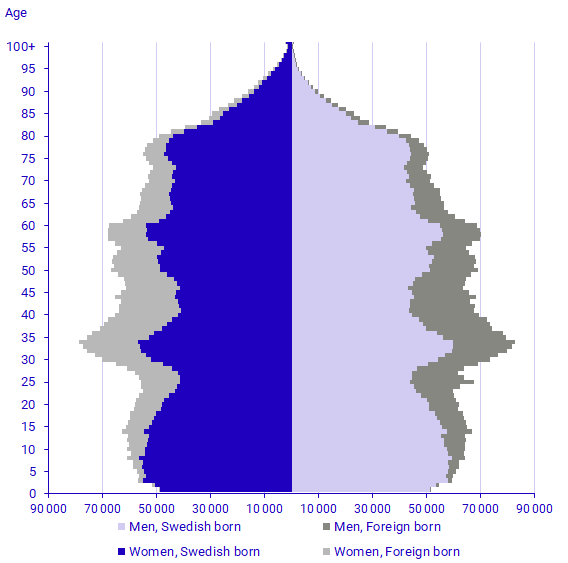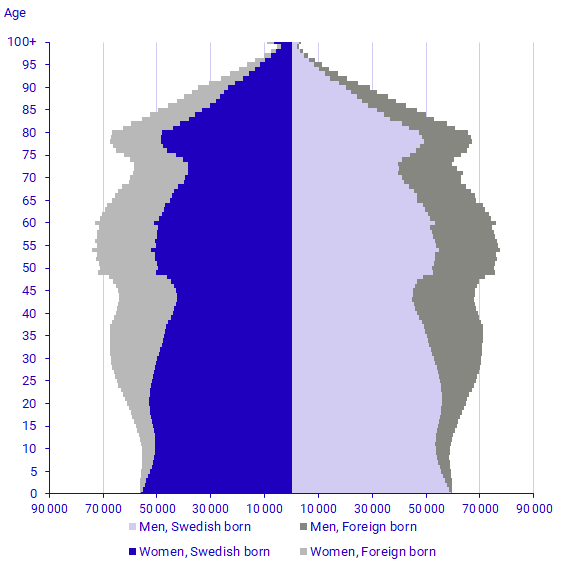Population by sex and country of birth 1970–2023 and projection 2024–2070
Population by sex, age and country of birth 1970

Population by sex, age and country of birth 2023

Population by sex, age and country of birth projection 2070

Comments
The population pyramids illustrate the population by age in 1970, 2023 and 2070. The number of women (in blue) and men (in light blue) in the population are shown on the left and right side of the pyramid, respectively. In each age group, the foreign born is shown in grey.
The cohorts born in the 1940s were young adults in 1970 and are above age 73 in 2023. The cohorts born in the 1950s were teenagers in 1970 and they are reaching the age of retirement in 2023. The large cohorts born in the mid-1960s were children in the 1970 age pyramid. In 2023, they are in age 56 to 59. The large cohorts born around 1990 are around 30-35 years old in 2023. In 2070 they are in age 76 to 82, shown in the age pyramid at the bottom.
The foreign born population in Sweden was relatively small in 1970. As shown in the age pyramid, it consisted mostly of young adults, aged 20–35. Since then, the number of foreign born individuals have increased in the population in all age groups. In 2023’s age pyramid, the largest number of foreign born residents is found in the ages 33–40.
In 2070, it is not possible to distinguish the cohorts that have not yet been born. In the projection of the population, we cannot predict changes in the number of born children due to, for example, economic fluctuations.
In general, there are more boys than girls born each year. Therefore, there is a surplus of males in the younger ages. However, as women live longer on average than men, there are more women than men in the older ages. In 1970 the number of women exceeded the number of men at age 50 and older. The life expectancy has since then increased more for men than for women and in 2023, there were more women than men in ages 65 and above. According to the Swedish population projection, this trend will continue, and in 2070, there will be more women than men in age 76 and over.
Some specific demographic events are visible in the age pyramids. There were relatively few children born in 1918 and 1919, the years of the Spanish flu. A greater number of children were born in 1920 and those individuals are present as 50-year-olds in the 1970 age pyramid. In 2010, there were more children born than in 2009 and 2011. They are visible as 13-year-olds in 2023 and as 60-year-olds in 2070. In 2023 there are many foreign born 24-year-old men. This is due to a large number of unaccompanied boys coming to Sweden as refugees in 2016–2017. In 2070’s age pyramid, they are still visible, as 71-year-olds, but not as clearly compared with nearby ages.
In the short term, this projection can be regarded as a population forecast. In the long term, the projection should be regarded as precisely a projection of the population in the case that current behaviour and trends continue in the future. Furthermore, an assumption is made that regulations that apply today will continue to apply throughout the projection period. Already in the short term, changes in society or in the world around us may mean that projection conditions will change.